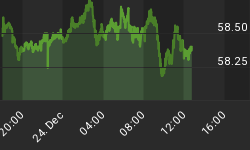I am disinclined to take victory laps when most people are losing money, but the recovery in commodities prices over the last week at the same time that bond and equity prices are both declining is a taste of success for my view that has been rare enough lately. That is, of course, the burden that a contrarian investor bears: to be wrong when everyone else is having fun, and to be right when no one wants to go out and celebrate. In fact, if you find yourself sharing your successes too often with other people who are having the same successes, I would submit you should be wary.
It is worth noting that the commodities rally has not been led by energy, despite the terrible violence in Egypt which threatens, again, to ignite a spark in the region. Today, the rise in commodities was led by gold and grains; yesterday by cows and copper (well, livestock and industrials).
I don't think that this is because of a sudden epiphany about inflation. In fact, although breakevens have been recovering from the oversold condition in June (more on that in a moment), the inflation data today did nothing to persuade inflation investors that more protection is needed. I gave some thoughts about the CPI report earlier today in this post, but suffice it to say that it was not an upside surprise. (And yet, there are starting to appear more-frequent smart articles on inflation risks. I commend this article by Allan Meltzer to you as being unusually clear-eyed.)
And commodities are not moving higher because of renewed enthusiasm about growth, I don't think. Today economic bell cow Wal-Mart cut its profit forecast because higher taxes are causing shoppers to be more conservative (perhaps in more ways that one). And, while today's Initial Claims figure was good news (320k versus expectations for 335k), weakness was seen in Industrial Production (flat, with downward revisions, versus expectations for +0.3%) and both Empire Manufacturing and Philly Fed came in slightly weaker than expectations. None of this is apocalyptic, but neither is it cause for elation about domestic or global growth prospects.
While the nascent commodity rally makes me personally feel warm and fuzzy, the more-momentous move is in what is happening to interest rates. And here I need to recognize that until very recently, I thought that bonds would follow the typical pattern of a convexity-exacerbated selloff: after a rapid decline, the market would consolidate for a few weeks and then recover once the overhang had cleared. I've seen it aplenty in the past, and that was the model I was operating on.
But I believe rates are heading higher. Although the overhang from the prior convexity selloff has probably been distributed, there is a new problem as illustrated by the news today about Bridgewater's "All Weather" fund. The All-Weather Fund is an example of a "risk parity" strategy in which, in simplified form, "low-volatility" strategies are levered up to have the same natural volatility as "high volatility" strategies. The problem is that levering up an asset class with a poor risk-adjusted return, as fixed-income is now, doesn't improve returns or risks of the portfolio at large. The -8% return of the AWF in Q2 illustrates that point, and makes clear to anyone who bought the great marketing of "risk parity" strategies that they probably have much more rate risk than they want (although according to the Bloomberg article linked to above, Bridgewater "hadn't fully grasped the interest-rate sensitivity" of being long 70% of net assets in inflation-linked bonds and another 48% in nominal bonds. I do hope that's a mis-quote).
The unwinding of some of that rate risk (Bloomberg called the panicky dumping of a relatively cheap asset class, TIPS, into the teeth of a retail and convexity-led selloff "patching" the risk) helped TIPS bellyflop in May and June, and to the extent that institutional investors wake up and reduce their levered long bets on fixed income we might see lower prices much sooner than I expected across the entire spectrum of fixed-income. Indeed, without the Fed or highly levered buyers, it's not entirely clear what the fair clearing price might be for the Treasury's debt. I was at one time optimistic that we would get a bounce to lower yields after a period of consolidation, but this news is potentially a game-changer. Although the seasonal patterns favor buying bonds in August and early September, the potential downside is much worse than the potential upside.
You can follow me @inflation_guy!
Enduring Investments is a registered investment adviser that specializes in solving inflation-related problems. Fill out the contact form at http://www.EnduringInvestments.com/contact and we will send you our latest Quarterly Inflation Outlook. And if you make sure to put your physical mailing address in the "comment" section of the contact form, we will also send you a copy of Michael Ashton's book "Maestro, My Ass!"
















